Djamila GIRAUD : Bellydance for rebirth
Thanks to Djamila GIRAUD, oriental dancer and teacher in Paris (France), for sharing her journey in all sincerity.
How did Bellydance come into your life?

I first encountered classical dance, which I practiced for 15 years. Then one day, almost 20 years ago, I left my position as head of publicity at the parliament to take care of my 3 children and then decided to resume my youthful passion for this discipline. It was then that I somewhat by chance met Lila Dari, an extraordinary bellydance teacher, partner in town and on stage of the famous oriental dancer and teacher Mayodi Sultan. This meeting was decisive for my life and my professional future.
I who, at 40, did not even know the existence of Egyptian dance, literally fell in love with this magnificent art.
I attended Bellydance's lessons with Lila for 5 years. After each class, I worked and practiced at home. I was terribly enthusiastic and determined. Very quickly, I knew that I wanted to make it my job and it became a real challenge. My parents even told me I was crazy…
I also went to all the oriental dance training courses that I could with, in particular, Youssry Sharif, Jillina, Amar Gamal or even Yaël Zarca and Oscar Florès.  At the end of a rigorous daily investment, my background in classical dance helping, I started to perform occasionally as a professional oriental dancer then everything went very fast. I was called for institutional and associative evenings then bachelorette parties, weddings, bar mitsvah. I danced a whole season in la Baule but also in Djerba, Marrakech and Dubaï.
At the end of a rigorous daily investment, my background in classical dance helping, I started to perform occasionally as a professional oriental dancer then everything went very fast. I was called for institutional and associative evenings then bachelorette parties, weddings, bar mitsvah. I danced a whole season in la Baule but also in Djerba, Marrakech and Dubaï.
I danced again and again while taking care of my 3 children. It was life in a whirlwind, at 100 mph. After I started as an oriental dance teacher for kids in 2 elementary schools.
Then there was an earthquake in my life, my divorce. This break put a brake on this career's promising start. I had to fight, alone with my children. They were my priority but Bellydance was my therapy.
I then gave more and more group and private oriental dance lessons but also workshops. There is nothing more educative than passing on your passion to students of various temperaments and levels.
I love my job even if I consider that the fracture that I experienced in my personal life prevented me from traveling and making myself better known. But it is never too late, this year I participated in the ODM festival in Spain and in the organized oriental dance competition where I placed 2nd in the "Golden Age" category.
You are a member of the International Dance Council, can you explain to us the role and missions of this organization in favor of dance and at the same time some of the actions/missions in which you participated in this context?

The CID organizes large gatherings of dancers all over the world to promote all dance types. When it was created, only classical dance was represented. Then, over the years, he opened up to other dances. The fact that it is under the aegis of UNESCO is a token of seriousness and professionalism.
They contacted me 5 years ago and then gave me a certification for my 15 years of dance.
As an experienced oriental dance teacher, you give 11 lessons per week in Paris apart from thematic workshops and private lessons. What are your secrets to manage this sustained pace physically, but also the resulting mental workload?

Indeed, it is not easy! I've experienced bouts of intense fatigue. I still have them regularly, especially after the end-of-year show where you don't count your hours. But I learned to rest because my age reminds me that if I want to last in this job, I have to take care of myself. I devote myself to an excellent lifestyle based on a good diet, rest, massages from time to time, regular consultations with a sports doctor but also with the physiotherapist and osteopath. Recharging my batteries with my family is also a precious point for my well-being.
What pedagogical techniques and tools do you use in your classes to make it easier for your students to learn Bellydance?

I break down each oriental dance move especially with beginners. I demonstrate patience and perseverance by showing again and again. I have them rehearse but always to music. I constantly try to capture their attention and correct them precisely. Also I sometimes use metaphors to make it easier for them to learn difficult combinations and help them visualize them better. I dance a lot with my students, it is essential to their learning. Finally, I also encourage them to attend my technical and thematic workshops to progress faster.
What is your perspective on the current Egyptian oriental dance scene?
Unfortunately there are less and less Egyptian dancers. I watch some of them which I sadly often find vulgar.
Oriental dancers from Ukraine and Russia are the most numerous. They have excellent technique but often lack the "oriental charm".
What styles, cuts, materials, colors, do you prefer when choosing your Bellydance costume? Tell us about your tastes in the matter…

I really like oriental dance costumes from the "Golden Era" style, I find them very elegant and sophisticated. In terms of colors, I love green in all its shades but also purple, gray and navy blue.
My Bellydance outfits were very heavy 15 years ago. Today, I prefer to dance with lighter and more comfortable pieces, especially flowy and floaty materials.
My students and I also appreciated the Baladi dresses ordered this year on your Bellydance store, thank you, very nice result as you can see!









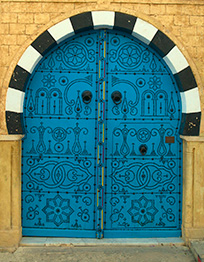





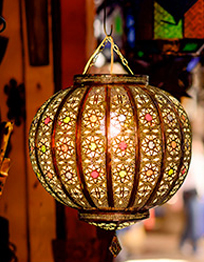


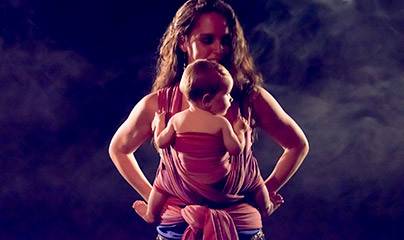
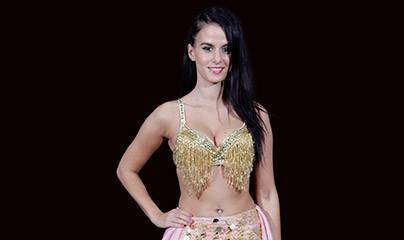

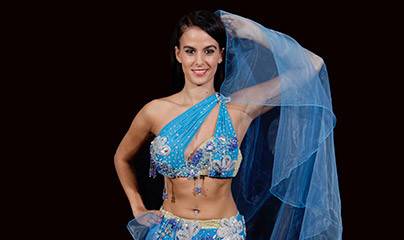

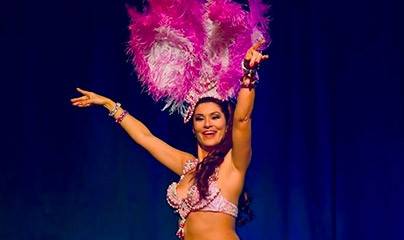
Leave a comment
Login to post comments